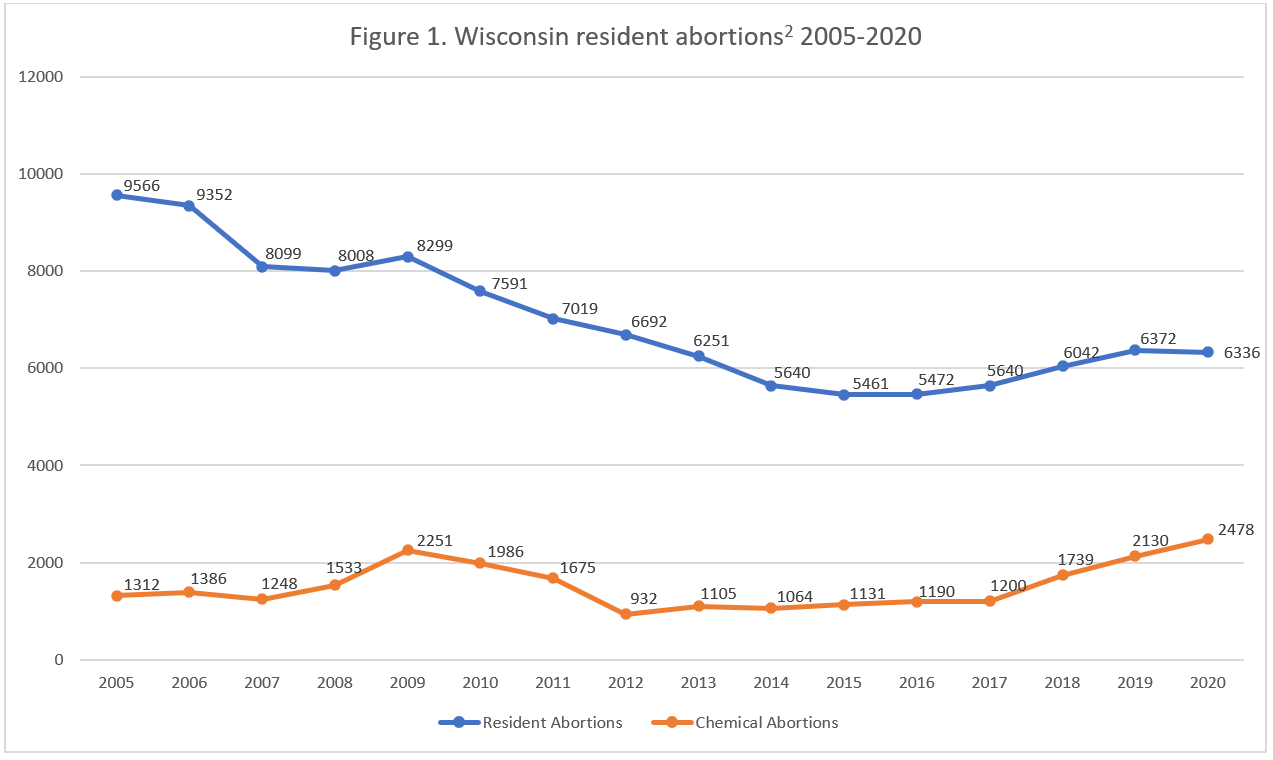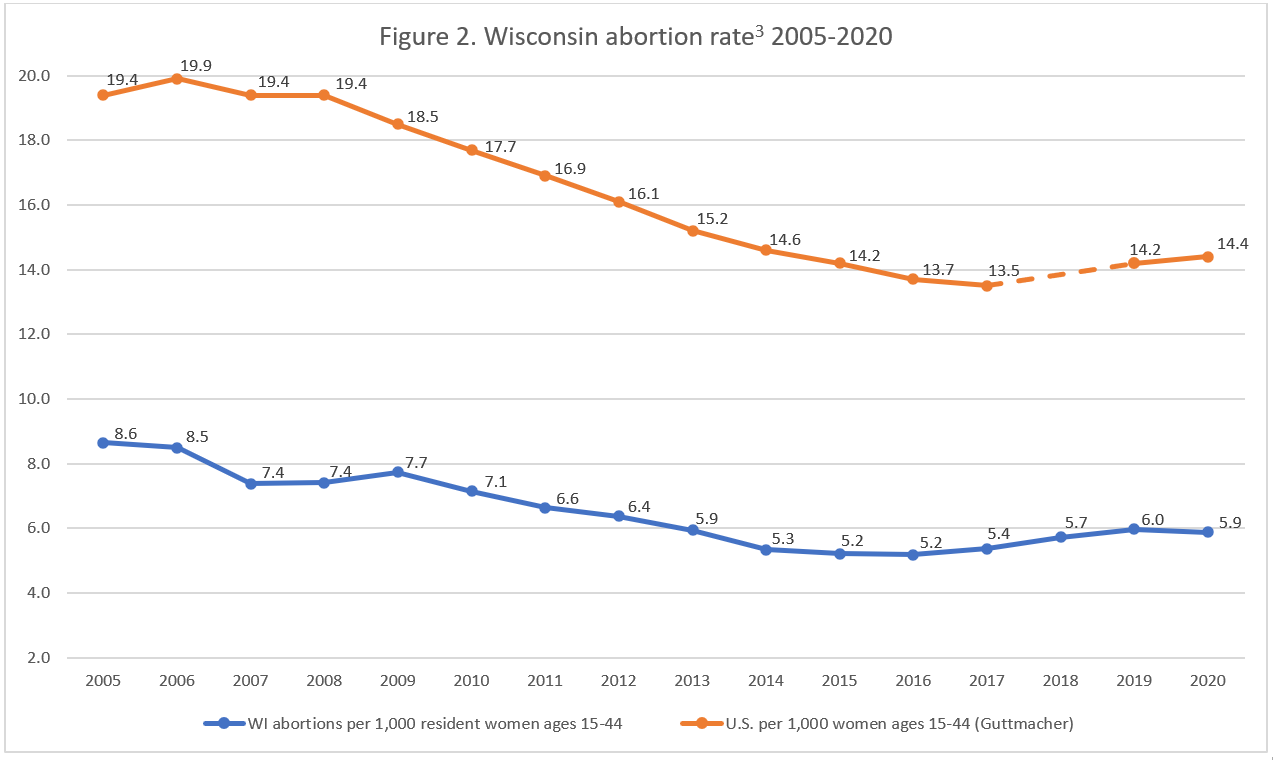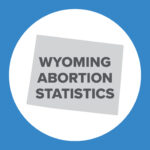Abortion Reporting: Wisconsin (2020)
Wisconsin’s 2020 abortion report was released in May 2022, showing that abortions in the state decreased for the first time since 2015. As of November 2022, 35 states had released 2020 abortion statistics; 22 of these states reported that abortions had increased from the previous year.
Statistics and Changes in Wisconsin Abortions, 2019-2020

The change in total abortions and chemical abortions reflects abortions performed on Wisconsin residents. The change in the abortion rate reflects all abortions reported in Wisconsin, including nonresidents. The report does not include information on Planned Parenthood’s Wisconsin abortion market share.
Abortion Totals and Trends
Wisconsin reported 6,430 abortions in 2020, down one percent from the year before. Of these, 6,336 were performed on Wisconsin residents, including 2,478 chemical abortions (Fig. 1). Chemical abortions performed on Wisconsin residents increased by 16 percent from 2019, making up 39 percent of Wisconsin resident abortions in 2020. The Charlotte Lozier Institute (CLI) estimates that Wisconsin’s abortion rate in 2020 was 5.9 abortions per 1,000 women ages 15 to 44 (Fig. 2), well below the national rate.
State Report Summary
The vast majority of the abortions reported in Wisconsin, 99 percent, occurred to Wisconsin residents. A little over one percent were performed on women from other states, including 56 abortions on Illinois women, 13 abortions on women from Michigan, 12 abortions on Iowans, and four abortions on women from Minnesota. Nine abortions were obtained by women from other states.
Ten percent of Wisconsin abortions were performed on girls under the age of 20, including three percent on girls under the age of 18. Thirty percent of the abortions were obtained by women ages 20 to 24, and 29 percent were performed on women ages 25 to 29. Nineteen percent were on women in their early thirties, and 10 percent were on women in their later thirties. Three percent of the abortions were performed on women ages 40 and older.
There were 188 abortions performed on Wisconsin residents under the age of 18, and the report includes information on the informed consent process for 185 of them. The report does not indicate whether consent was obtained for the remaining three abortions. Fewer than five abortions were performed on emancipated minors, although the exact number was suppressed. Nineteen minors obtained judicial waivers to Wisconsin’s parental consent requirement, and 165 minors had adults provide consent on their behalf. Of these 165 cases, 138 had consent provided by a parent, 24 had consent provided by a different adult family member, and fewer than five had consent provided by a guardian or legal custodian.
Over half the abortions (55 percent) were performed on white women. Thirty-four percent were obtained by black women, and three percent were performed on Asian or Pacific Islander women, including 0.7 percent on Laotian or Hmong women. One percent of Wisconsin abortions were performed on American Indian women. Two percent of the abortions were on women of other races, and three percent were on women of multiple races. Race was not reported for two percent of the abortions. Eighty-seven percent of Wisconsin abortions were on non-Hispanic women, 12 percent were on Hispanic women, and one percent were on women of unknown ethnicity. CLI estimates that there were 24.4 abortions per 1,000 black women ages 15-44 in 2020, over six times the white abortion rate of 3.8.
A large majority of the abortions reported in Wisconsin (87 percent) were performed on unmarried women. Twelve percent were obtained by married women, and one percent were performed on women of unreported marital status. Eight percent of the abortions were obtained by women who had not graduated from high school. Forty-four percent were performed on women with a high school diploma or GED, and 34 percent were performed on women with some college education or an associate’s degree. Thirteen percent were obtained by women with a bachelor’s degree or more. Education was not reported for one percent of the abortions.
Sixty-one percent of the abortions performed on Wisconsin residents were surgical, and 39 percent were chemical. There were 21 abortions that were failed chemical abortions completed surgically. The Wisconsin Department of Health Services previously informed CLI that it was unable to determine whether any of these incomplete abortions were also counted in the chemical abortion total. If these chemical abortions were double counted, they would slightly inflate Wisconsin’s 2020 abortion total.
Fifty-nine percent of the abortions reported in Wisconsin were performed at eight weeks of gestation or earlier. Nineteen percent occurred between nine and 10 weeks, and nine percent were performed between 11 and 12 weeks of gestation. Seven percent were performed between 13 and 15 weeks, and five percent were reported from 16 to 20 weeks of gestation. There were 53 abortions (0.8 percent) performed after 20 weeks of gestation. Unless in cases of medical emergency, abortion in Wisconsin is limited at 20 weeks post-fertilization, around 22 weeks of gestation. The report cautions that gestational age data can be inconsistent and imprecise because some providers report the length of pregnancy from the woman’s last menstrual period, and some provide an estimate of gestational age.
In 2020, 89.7 percent of the abortions were reported to have no complications, similar to 89.4 percent.1 Multiple complications can be reported for each abortion, and the most commonly reported complication was retained products of conception, occurring 36 times, a dramatic decrease from 2019 when retained products occurred in 621 cases and a slight decrease from 2018’s number of 73. There were 15 cases of hemorrhage, up from five cases in 2019. There were five infections and 607 other, unspecified complications, an increase from the previous year. Because the percent of abortions without complications held steady, and “other” complications increased slightly, it is possible that the sudden decrease in retained products was a result of providers checking only the “other complication” box on the complication reporting form. The report acknowledges the possibility that “some complications are missed or misreported.”
Legislative Changes
After the United States Supreme Court’s Dobbs decision overturned Roe v. Wade in June 2022, Wisconsin’s Pre-Roe trigger law, limiting all abortions except when the life of the mother is in danger, went into effect. In September 2022, the Wisconsin Attorney General, Josh Kaul, sued the three top district attorneys in the counties where the state’s three remaining centers were operating before Roe was overturned in an attempt to block enforcement of Wisconsin’s pre-Roe trigger law. Since the 2022 Dobbs decision, the state’s three abortion clinics stopped performing abortions.
State Ranking
In 2016, CLI evaluated abortion reporting in the 50 states, New York City, and the District of Columbia. Wisconsin’s reporting was tied for 17th best. To improve its reporting, Wisconsin could report abortion procedures with more specificity, such as elaborating on the types of surgical abortions used (suction aspiration, dilation and evacuation, etc.). Wisconsin could also be more specific in its complications reporting by indicating whether complications stemmed from a chemical or surgical abortion. Lastly, Wisconsin could also collect and report information on women’s reasons for seeking abortions, as some states do.


- Statistics on abortion complications reported here represent a minimal number of deaths and complications, as this data is collected in a non-systematic and non-verifiable way. As such, this data cannot be used to calculate either an accurate abortion mortality rate or an accurate abortion complication rate for the state. The report cautions that “Assessing the incidence of complications is somewhat problematic. Some complications do not occur immediately or become apparent while the patient is in post-procedure recovery, therefore some complications are missed or misreported.”
- Because the Wisconsin Department of Health Services is unable to tell whether an incomplete chemical abortion was previously reported as a chemical abortion, these incomplete abortions are not included in the chemical abortion totals. Consequently, chemical abortion totals depicted here differ from those reported in previous articles.
- Rates were calculated by CLI using the following formula: (total number of abortions performed in Wisconsin ÷ number of resident women ages 15-44) x 1,000. Rates may differ slightly from previous CLI articles due to revised population estimates. Population estimates were obtained from the CDC WONDER database. Estimates for 2005-2009 are intercensal estimates of the July 1 resident population. Estimates for 2010-2020 are Vintage 2020 postcensal estimates of the July 1 resident population. Estimates were produced by the U.S. Census Bureau and the National Center for Health Statistics.

























